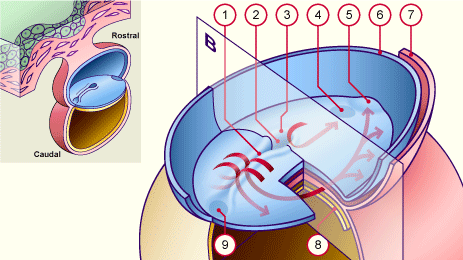|

|
|
|
7.2 The trilaminar germ disk (3rd week)
|
|
|
Genesis of the germ layers
|
|
|
| Fig. 3 - Primitive streak seen dorsally |
|
Legend |

1
2
3
4
5
6
7
8
9
NB |
Primitive groove
Primitive pit
Primitive node
Oropharyngeal membrane
Cardiogenic plate
Sectional edge of amniotic membrane
Mesoderm
Endoderm
Future cloacal membrane
1+2+3 primitive streak |
|
|
|
Fig. 3
Oval-shaped embryonic disk (dorsal view).
The red arrows show schematically the migration directions of the epiblast cells to their points of final destination.
|
The epiblast is a precursor of three cell layers in the trilaminar embryo:
- Ectoblast/-derm
- Mesoblast/-derm
- Definitive endoblast/-derm
|
|
|
|
|
|
More info
|
|
The cellular adhesion molecules (or CAM):
Starting with gastrulation the epiblast cells secrete hyaluronic acid, which gets deposited in the intercellular spaces between the epiblast and the hypoblast. This molecule is able to bind a large amount of water to itself (up to 1000 times its own weight), is often associated with cell migration, and plays an anti-aggregational role for the mesoblast cells. The presence of hyaluronic acid, however, does not suffice to explain the migration of the epiblast cells away from the primitive streak.
In vertebrate embryos it is assumed that the migration also depends on the presence of fibronectins that are found on the basal lamina under the epiblast. Fibronectin is an extracellular glycoprotein (10).
The integrins:
The integrins belong to the 4 families of the Cell Adhesion Molecules (CAM): integrin, cadherin, selectin, and the large family of the immunoglobulins. They are responsible for the recognition and binding of two cells with each other or a cell and components of the extracellular matrix. The kind of the connection can be homophil (two identical molecules) or heterophil (two differing molecules bound to each other). Being transmembranal glycoproteins, integrins insure the cohesion (aggregation) and influence the migration of cells. They are also responsible for the organization of the cells in the tissue and the tissue in the organs. The integrins arrange contacts with the collagen filaments in the basal membrane and the extracellular matrix. Laminin is a ligand of the basal membrane. Fibronectin, on the other hand, is a ligand of the intercellular substance of e.g. the mesoblast and plays a role in cell migration.
|
|
|
|
|
|
|

